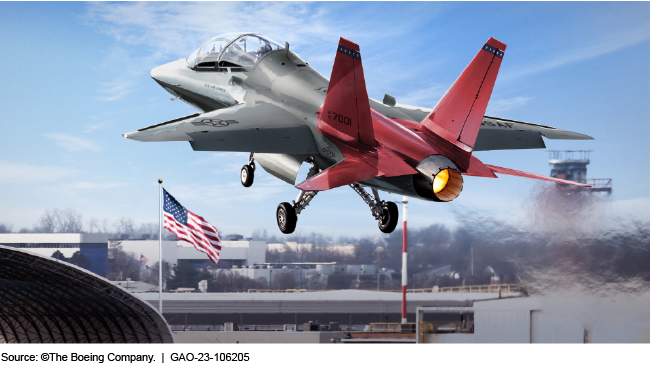Advanced Pilot Trainer: Program Success Hinges on Better Managing Its Schedule and Providing Oversight
Fast Facts
The Air Force has been using the same aircraft to train pilots for over 60 years, even as military plane designs have evolved. A new system of modern training jets and simulators is in the works, but is nearly a decade behind initial plans.
Also, the Air Force's delivery schedule for the new training system isn't realistic. The schedule doesn't account for the risk of developing, testing, and building the system at the same time. And while the Air Force usually oversees production through its contracting processes, it can't do so because the planes currently being built aren't yet under contract.
Our recommendations address these issues.
An illustration of the Air Force's new trainer jet

Highlights
What GAO Found
To train its pilots, the Air Force uses an aircraft designed especially for this purpose—the T-38 trainer jet. However, this trainer jet is more than 60 years old. Since 2011, the Air Force has been developing a trainer jet and flight simulator package, known as the Advanced Pilot Trainer, to replace the T-38 trainer jet. In late 2016, the contractor completed two prototype aircraft. The Air Force signed a contract in September 2018 for the development of the new trainers.
The Air Force has yet to resolve significant issues with the Advanced Pilot Trainer, including with its escape system and other components critical to achieving requirements. For example, the escape system—including the canopy fracturing system—does not yet meet safety standards. Therefore, the Air Force will not yet allow pilots to fly the test aircraft. Officials said the Air Force can resolve all of these issues, but it will likely take several years.
GAO Illustration of the Advanced Pilot Trainer Escape System

The Advanced Pilot Trainer is nearly 10 years behind its initial estimate. In January 2023, the contractor developed a new schedule to reflect recent delays. However, according to Air Force program officials, this new schedule is also optimistic, relying on favorable outcomes not supported by past performance. In January 2023, the Air Force conducted a schedule risk assessment but did not assess two key risks. One of these risks is overlap between key program phases, which magnifies the cost and schedule impact of potential issues discovered during testing. Cascading delays increase reliance on the T-38 trainer or fighter jets for training, both of which are costly options.
Delays have also affected contractor decisions regarding manufacturing, with implications for the Air Force's quality assurance, which GAO refers to as oversight. Given development delays, the Air Force has not yet ordered aircraft beyond five initial test aircraft. But, the contractor began producing parts in March 2022 and intends to begin assembling aircraft in early 2024. The Air Force has not ordered production aircraft, so its traditional means of overseeing aircraft production is not viable, reducing confidence that this work will meet not-yet-established contract specifications. With limited oversight of production prior to ordering aircraft, the Air Force does not have a plan for determining under what conditions it would accept production work completed prior to contract delivery.
Why GAO Did This Study
The Air Force's Advanced Pilot Trainer program intends to replace the T-38 trainer jet, which is increasingly expensive to maintain and not reflective of modern fighter jets and other aircraft. The Advanced Pilot Trainer is behind schedule, increasing strain on Air Force resources as it maintains aging aircraft while developing the new aircraft.
A House report included a provision for GAO to assess the Advanced Pilot Trainer program. This report examines (1) any development challenges the program is facing, (2) the program's schedule targets and any risks to those targets, and (3) manufacturing plans for the aircraft.
To conduct this work, GAO assessed the extent to which the Air Force has developed and tested key technologies against program objectives. GAO reviewed the program's schedule and compared it to baseline estimates and GAO's best practices for schedules. Lastly, GAO assessed the program's manufacturing plans against federal regulations and DOD policy. GAO interviewed DOD and Air Force officials and contractor representatives.
Recommendations
GAO is making two recommendations to the Air Force to (1) ensure the program conducts a risk assessment that incorporates risks of overlapping development, testing, and production phases, and (2) make a plan for determining under what conditions it would accept production work completed prior to contract delivery. DOD concurred with our recommendations.
Recommendations for Executive Action
| Agency Affected Sort descending | Recommendation | Status |
|---|---|---|
| Department of the Air Force | The Secretary of the Air Force should ensure that the APT program conduct a schedule risk assessment that includes (1) risks associated with the overlap of development, testing, and production phases of the program, and (2) risks related to contractor management. (Recommendation 1) |
Open
The Air Force concurred with this recommendation. As of August 2023, the Air Force has yet to provide us with information that these risks were factored into its current production start date of February 2025.
|
| Department of the Air Force | The Secretary of the Air Force should make a plan for determining under what conditions it would accept production work completed prior to contract delivery. (Recommendation 2) |
Open
The Air Force concurred with this recommendation. As of August 2023, the Air Force has yet to make a plan for pre-contract surveillance or articulate the condition under which it would accept aircraft built prior to the contract date.
|
